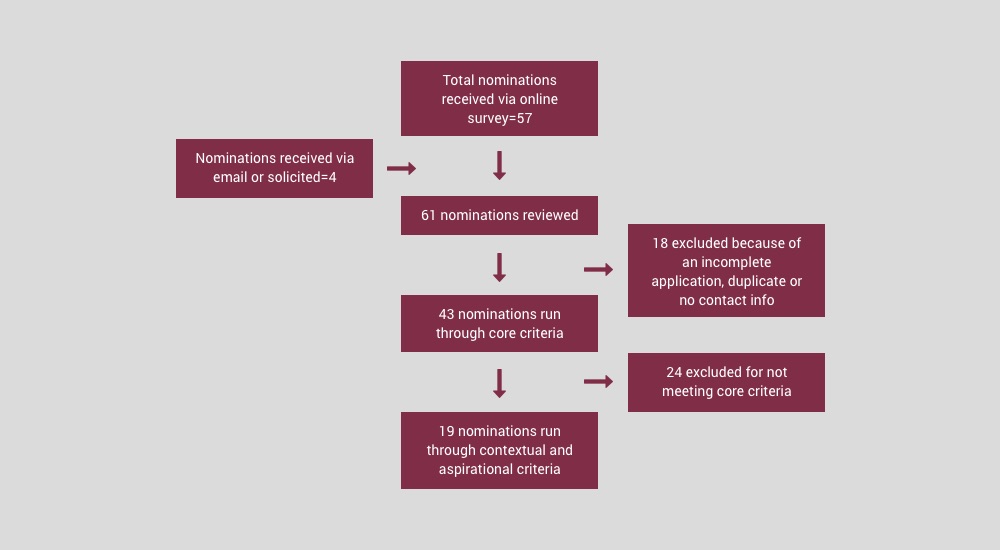Policy Database Methodology
The HFFP Policy Database focuses on written laws and organizational policies that have been formally adopted by municipal governments such as counties, cities, towns, and villages. These include ordinances, resolutions, and codified laws. The Policy Database does not include laws and policies adopted by school boards, park boards, and other types of special local governments. The Database also does not include state, federal, or Tribal laws; these types of governments are very different from municipal governments, with different structures and different priorities.
Although excluded laws and policies may have relevance to healthy food access in some way and may be important, they either did not expressly articulate a connection to healthy food access, or expressed a connection but did not include enforceable or specific duties or requirements. Many of these types of laws are included in our Food System Crosswalk.
Excluded policies include those that are aspirational or advisory; or that establish a framework; or that create a taskforce, commission or similar body without requiring some kind of specific, described policy-related action by a prescribed deadline.
Examples include:
- resolutions merely stating a commitment to promoting healthy food access
- ordinances or resolutions approving the acceptance of grants for a healthy food access related initiative; or honoring a person or entity for healthy food access related work
- laws that approved contracts or appropriations relating to food but did not include substantive provisions relating to access to healthy food
- comprehensive plans and other kinds of plans
- laws or resolutions that establish a food policy council, or workgroup, taskforce, commission, or similar body, unless the body is charged with taking specific, identified policy actions within a defined time period
We also excluded certain categories of laws, including:
- laws authorizing transfer of development rights from agricultural zones to non-agricultural zones, and other laws focused on preserving agricultural land, soil quality, or the environment that do not also specifically refer to food crops, fruit and vegetable production, or similar healthy food related concepts
- general food safety, handling, sanitation, and labeling laws
- laws that establish general requirements for institutional food service or other public feeding programs or services, such as senior dining programs, meals on wheels, or summer camp programs, unless the requirements include specific, articulated “healthy food” standards
- laws relating to permits or licenses for food retail outlets such as stores, farmers markets, and mobile markets or vendors unless they also address acceptance of federal nutrition program benefits, or set minimum requirements or standards for offering of fresh produce or other healthy foods
- laws that establish general requirements for kitchens in residential structures (unless specific to boarding houses, rooming houses, or communal kitchens in parks, manufactured home parks, and the like)
- laws merely approving budgets or appropriations for farmers’ markets, city markets, community gardens and other potential fresh produce related access points, unless they were included or part of laws regulating these types of access points
- lists and tables in zoning laws that merely identify whether urban agriculture or farmers’ markets or similar activities are permitted or conditional uses
- urban agriculture laws that were very long (dozens of pages in length) or so interspersed throughout a lengthy zoning code that coding them consistently was not possible
- laws that exempt nursing mothers from public indecency laws or merely refer to breastfeeding in the context of paid parental leave
This is a partial, not exhaustive, list. We also made exceptions for laws or policies included in the Growing Food Connections database. Our Coding Manual, which has more information about our policy selection and coding process, is available here. The manual is continuously updated. This linked version is current through May 3, 2019.
Case Study Methodology
To solicit case study nominations from rural, suburban, and urban communities, the Healthy Food Policy Project (HFPP) team sent a solicitation email through various listservs. We contacted a variety of institutions including universities, research centers, local government entities, and non-profit organizations, (N=234) on May 31, 2017. The solicitation email contained a link to an online survey that collected basic information on the community, the type(s) of local level law(s) enacted, the economic and/or environmental impact of the policy change(s), and the extent in which the law(s) aimed to achieve health equity for priority populations. The submission deadline was June 15, 2017.
A decision matrix developed by the project team guided the selection process. The matrix included both core criteria (e.g., type of law or plan, impact on health equity), contextual criteria (e.g., geographic location, median household income), and aspirational criteria (e.g., intentional efforts to ensure that community groups likely to be impacted by the law were actively included in the policy development process).

The 19 case studies included in the final selection process were analyzed further by the case study team using the contextual and aspirational criterion. The HFPP coding database was used, when applicable, for additional information specific to the codified law. These results were shared with the entire project team and through a collaborative decision-making process, the team chose the 4 case studies included with the HFPP launch.
For the case study solicitation email and online survey, click HERE.


